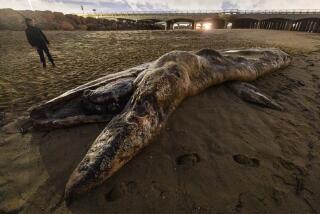Swimming with giant sharks is not as scary as it sounds
What kind of suicidal fool goes swimming with a giant shark? Well, I did, actually. And I still have all four limbs.
The whale shark, found off southern Baja California, grows up to 50 feet long. It is unquestionably the biggest shark on the planet, greater than the great white and bigger than the hammerhead.
Fortunately for me, this sea monster has no teeth.
The whale shark is one of the few species of shark that is a filter feeder. It subsists on plankton, krill and other animals and plants that drift through the ocean.
I kept this happy fact in mind as I set out one clear November morning on a tarp-topped motorboat bound for the Bay of La Paz, the monster fish’s favorite feeding ground.
I was one of five tourists who had signed up for a half-day snorkeling excursion with Mar y Aventuras/Sea & Adventures, a family-run tour operator in La Paz. There was no backing out, at least not with my pride intact.
“These sharks eat plankton, not people,” Benjamin, our guide, told us as our boat charged into the bay. “You have nothing to worry about.”
But I did worry. A lot.
“The whale shark’s head is broad and flat, with a somewhat truncated snout, and an immense mouth,” Encyclopedia Britannica told me.
Even if I didn’t get eaten, surely it was possible to be swallowed whole like some unfortunate modern-day Jonah.
My fretting was interrupted with a piercing cry.
“Look,” Benjamin shouted as he pointed to a massive dorsal fin swishing through the water just yards from the boat. “Let’s go.”
All five of us clambered toward the side, pulling on flippers and life jackets. Laura, a high school student from Colorado, didn’t seem flustered. She strapped on her snorkel mask with determination, took a deep breath and jumped into the water.
Savor Puebla, a Mexican gem known for its food and sense of style »
I followed at a cautious distance.
It took a moment for the bubbles to clear, but when they did I found myself face to face with a 20-foot creature, its lean, blue body careening through the crystal tide.
It was a beautiful spectacle, but it didn’t last long. The encyclopedia had claimed that whale sharks were “slow-moving creatures.” Not this one; it took every ounce of my energy to keep up with it.
After 10 minutes of strenuous kicking, I gave up the chase and swam back to the boat.
“How was that?” I asked Laura, when everyone had climbed inside.
“Amazing,” she said. “I’ve been freaking out about this for three whole weeks. But it was definitely not as scary as I thought.”
I agreed. It didn’t seem scary at all. If anything, I felt sorry for the animal, pursued by this gaggle of snorkeling tourists.
“How old do you think it was?” I asked Benjamin, as we all sat down for a well-earned snack.
“I’ve no idea,” he said. “They can live to be 100. But we don’t know much else about them. As far as I’m aware, no one has ever seen them mate or give birth.”
Semarnat, Mexico’s environmental agency, claims that 56% of the whale sharks in the Gulf of California have been injured by tourist boats. Could this be why our fishy friend was in such a hurry to escape?
The government has tightened restrictions on snorkeling trips, Benjamin said. Only five tourists can swim with a shark at any time, he said, and fewer boat permits have been issued than in the previous year.
I still felt a twinge of guilt, but there was little time for soul searching. Another dorsal fin appeared, and all five of us were back in the water, paddling furiously and jostling for the clearest view.
This shark was smaller (perhaps 8 feet long) and much slower than our previous swimming partner. It seemed — or was I imagining it? —more playful than its bigger, faster cousin.
I returned to La Paz later that afternoon and strolled down the Malecón, the palm-fringed promenade that author John Steinbeck once described as “a Hollywood production.”
Steinbeck was pessimistic about the future of La Paz. “Probably the airplanes will bring weekenders from Los Angeles,” he wrote in “The Log From the Sea of Cortez,” “and the beautiful poor bedraggled old town will bloom with a Floridian ugliness.”
I myself was a weekender from Los Angeles. But I saw no signs of ugliness, Floridian or otherwise. La Paz has somehow managed to avoid the rampant construction that blights other parts of the Mexican coast. These days, it’s a friendly and attractive place.
I slipped into the newly opened Museo de la Ballena (Museum of the Whale) just before sunset. There were shark models on display. And whale skeletons too. But not a whale shark in sight.
No matter. I’d been fortunate enough to see this tourist-shy leviathan in the flesh. And more than that, I’d lived to tell the tale.
If you go
THE BEST WAY TO LOS CABOS, MEXICO
From LAX,
WHAT TO KNOW
Mar y Aventuras, www.kayakbaja.com, offers whale shark snorkeling tours from $75 per person, including guide, snorkel gear, drinks and snacks. Whale shark season in La Paz is October to April.
WHERE TO STAY
Posada LunaSol, 5 de Febrero, 564 Topete, La Paz; 011-52-612-122-7039, www.posadalunasol.com. Doubles from $70 a night.
Costa Baja Resort and Spa, Carretera a Pichilingue, La Paz; (877) 392-5525, www.costabajaresort.com. Doubles from $225 a night.
More to Read
Sign up for The Wild
We’ll help you find the best places to hike, bike and run, as well as the perfect silent spots for meditation and yoga.
You may occasionally receive promotional content from the Los Angeles Times.






